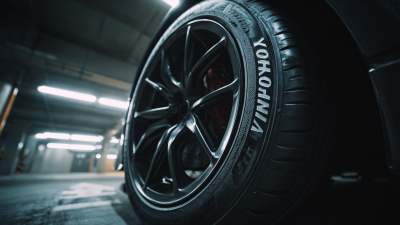In the fast-paced world of automotive engineering, the selection of
performance tires plays a crucial role in enhancing vehicle
handling and safety. According to the
2022 Tire Industry Association report, approximately 30% of consumers
underestimate the impact that tires have on overall vehicle performance, including braking distances and
cornering stability.
 Performance tires, designed with advanced rubber compounds and
tread patterns, provide superior grip and responsiveness on both wet and dry surfaces. Furthermore, studies indicate
that switching to high-quality performance tires can improve handling by
15-20% and reduce stopping distances significantly—up to
30 feet at highway speeds. As drivers seek to boost their
vehicle dynamics while ensuring safety, understanding the intricacies of performance tires becomes paramount in making
informed decisions that align with their driving preferences and conditions.
Performance tires, designed with advanced rubber compounds and
tread patterns, provide superior grip and responsiveness on both wet and dry surfaces. Furthermore, studies indicate
that switching to high-quality performance tires can improve handling by
15-20% and reduce stopping distances significantly—up to
30 feet at highway speeds. As drivers seek to boost their
vehicle dynamics while ensuring safety, understanding the intricacies of performance tires becomes paramount in making
informed decisions that align with their driving preferences and conditions.
When selecting performance tires, several factors significantly influence vehicle handling and safety. First, the tire's tread design plays a crucial role in ensuring optimal grip on various surfaces, allowing for better cornering stability and shorter braking distances. A well-designed tread pattern can channel water away, reducing the risk of hydroplaning and improving wet traction, which is essential for maintaining control in adverse weather conditions.
Another critical consideration is the rubber compound used in the tire's construction. Softer compounds typically offer superior grip, enhancing acceleration and cornering performance. However, they may wear out faster. Additionally, tire width and aspect ratio contribute to overall handling. Wider tires often provide a larger contact patch with the road, increasing traction, while a lower aspect ratio can enhance responsiveness, providing drivers with a more connected feel to the road. Ultimately, understanding these factors helps ensure that your choice of performance tires aligns with your vehicle's requirements and your driving style.

When selecting high-performance tires, several essential features must be considered to ensure optimal grip and stability. Firstly, tire tread design plays a pivotal role in enhancing traction. According to a report by Tire Business, tires with specialized tread patterns can improve wet and dry handling by up to 30%, making them critical for those who prioritize vehicle performance under varying conditions. A deeper understanding of the tread depth also reveals that tires with a depth of 7 to 9/32 inches can significantly outperform those with shallower depths in terms of water evacuation and hydroplaning resistance.
Another crucial aspect is the tire compound. Performance tires typically utilize a softer rubber compound that enhances grip, especially in high-speed situations. In fact, studies indicate that vehicles equipped with high-performance tires can achieve up to 15% shorter stopping distances compared to standard tires. Additionally, reinforced sidewalls provide added stability during sharp cornering, which is essential for maintaining control. Coupled with lower aspect ratios, these features work together to create a responsive driving experience, making high-performance tires a must-have for enthusiasts seeking improved handling and safety.

When selecting performance tires, it’s essential to consider the best brands that cater to various weather conditions. For dry conditions, Michelin is often hailed for its advanced tire technology, providing exceptional grip and handling. Models like the Michelin Pilot Sport 4S are designed to enhance cornering and braking performance, making them ideal for spirited driving.
In wet and rainy climates, Bridgestone stands out with its Potenza series, particularly the Potenza RE980AS. This tire features innovative tread patterns that channel water away, minimizing hydroplaning risks while offering reliable traction. Additionally, their performance in both wet and dry conditions ensures that you maintain control regardless of the weather.
For colder climates with snow and icy roads, Goodyear's Eagle Exhilarate is worth considering. This tire incorporates a unique winter compound that stays pliable in low temperatures, ensuring better grip. Its aggressive tread design also enhances traction, allowing for safer navigation through winter weather.
Tips: Always check tire ratings and reviews for their performance in specific weather conditions before making a purchase. Regularly inspect your tires for wear and maintain proper inflation to maximize safety and handling. Finally, consult a tire professional if you're uncertain about the best options for your vehicle and driving habits.
When it comes to selecting performance tires, understanding the four key types is crucial for enhancing vehicle handling and safety. The first type is the all-season tire, which offers a balanced performance across various weather conditions and is suitable for everyday driving. While they provide decent grip and comfort, they may compromise on performance during extreme weather situations.
The second type is the summer tire, specifically designed for warmer conditions. These tires feature a softer rubber compound that enhances grip on both dry and wet roads, optimizing handling and braking performance. However, they are not suited for snowy or icy surfaces. The third type, winter tires, are essential for driving in harsh winter conditions. Their unique tread patterns and rubber compounds ensure maximum traction on snow and ice, making them indispensable for safety in cold climates.
Finally, high-performance tires cater to enthusiasts who demand superior handling and responsiveness for dynamic driving experiences. These tires often come with specialized tread designs that enhance cornering stability and provide feedback to the driver. By understanding these different types of performance tires, drivers can make informed choices to elevate their vehicle's safety and handling capabilities in various driving conditions.
When it comes to maximizing the longevity of your performance tires, regular maintenance is key. Performance tires are designed to provide superior handling and grip, but they require proper care to maintain their characteristics. Here are some essential tips for upkeep.
Firstly, regularly check your tire pressure. Under-inflated tires can lead to increased wear and reduced fuel efficiency. Maintaining the manufacturer's recommended pressure ensures optimal contact with the road, enhancing performance and safety. Needing less frequent rotations, performance tires should still be rotated approximately every 5,000 to 7,500 miles to promote even wear across all tires.
Another critical aspect is monitoring tread depth. Performance tires often wear down faster in critical areas, which can compromise traction. Use a tread depth gauge to check levels regularly; replace tires when tread depth falls below 3/32 inches. Additionally, careful alignment and balancing of tires can prevent uneven wear and maintain proper handling, ensuring you enjoy the full benefits of your investment in performance tires.






Reignite your passion for driving with Yokohama tires and experience the superior performance you deserve.